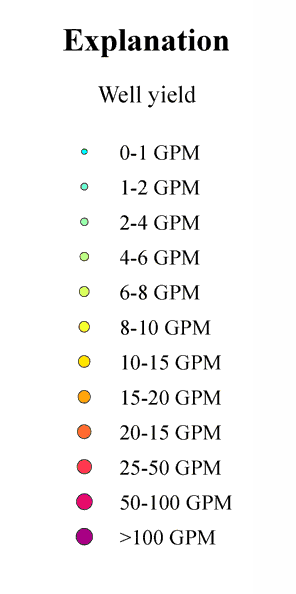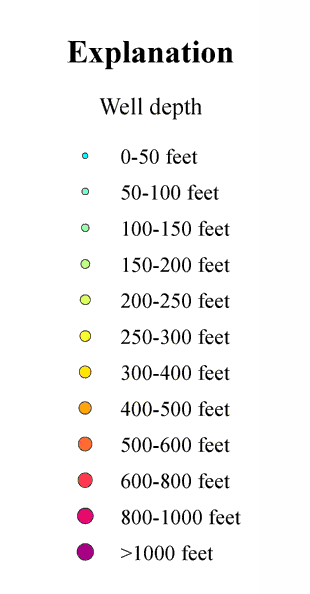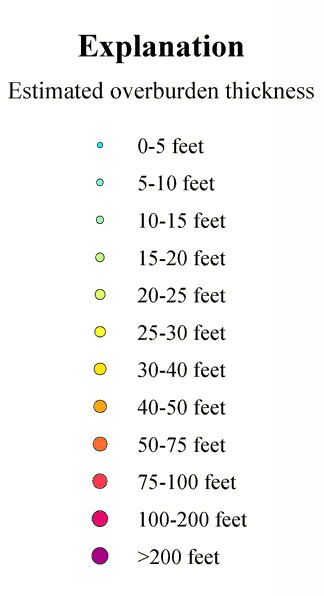DACF Home → Bureaus & Programs → Maine Geological Survey → Maps, Publications and Online Data → Using Geologic Maps → Bedrock Ground-Water Resources Maps → Explanation
Explanation of Information Shown on Bedrock Ground Water Resources Maps
This series of maps presents the basic information collected to date by the bedrock ground water resources program. The information presented on these maps provides a first step towards evaluating and understanding the bedrock ground water resource. The information portrayed on these maps may be used by agencies involved in ground water protection and ground water remediation efforts, development permit review, and planning efforts.
Characterization of the bedrock ground water resource is complicated by the nature of ground water flow through crystalline bedrock. This flow is controlled by the distribution and characteristics of brittle fractures in the bedrock. Brittle fracture systems cannot be mapped easily. Estimating the hydraulic properties of brittle fracture systems is also difficult. At the present time, the Maine Geological Survey's bedrock ground water resources program primarily involves collecting, analyzing, and publishing information on bedrock wells drilled by commercial well drillers.
Accurate well locations are essential if the maps are to provide a useful summary of well information. Wells shown on these maps were located through a process of matching the well ownership and well location information provided by the well drillers with property tax records in local town offices. For wells successfully matched with a property, the well location was transferred from the tax map to a 1:24,000 U.S. Geological Survey quadrangle map. Well locations were digitized from the 1:24,000 map and plotted at the summary map scale of 1:125,000.
BEDROCK WELL YIELDS
 |
This map shows bedrock well yields as estimated by well drillers. Well yield as reported by the well drillers is generally air lift yield or yield estimated by bailing. Because the yield is measured for only a short period of time, both methods for estimating yield may lead to imprecise estimates of sustainable well yield. To avoid placing too much emphasis on individual well yields, wells are grouped into categories based on the reported yield. Clusters of wells with yields of 10 gallons per minute or more may define zones favorable for bedrock ground water exploration. At the scale of these maps, however, the brittle fractures that are the primary control on well yield may be smaller than the well symbol. For this reason, we have not attempted to outline zones of high yield wells on this map, and want to emphasize that the yield data presented on the map should be used cautiously when evaluating potential well yields in an area. |
BEDROCK WELL DEPTHS
 |
This map shows well depths as estimated by well drillers. Well depth (and casing length) are the two most reliable pieces of data reported by well drillers. Wells are grouped into categories based on the reported well depth. The final depth of a well depends on where water-bearing fractures are encountered in the well, the well yield, and the estimated peak demand. Sufficient casing storage must be provided to supply peak demands in low- and intermediate-yielding wells, and the pump must be placed deep enough to provide protection against drawdown during heavy use. |
ESTIMATED OVERBURDEN THICKNESS
 |
This map shows the overburden thickness (depth to bedrock) as estimated by well drillers. Overburden thickness is used by the driller to determine the length of casing needed to seal the well from direct infiltration of shallow ground water. In areas with thin glacial cover and competent bedrock, recognizing the change from unconsolidated deposits to bedrock is straightforward. In areas with thick glacial cover, however, recognizing the change may be more difficult. This may be especially true in areas where the underlying bedrock is fractured and/or deeply weathered. On the map, wells are grouped into categories based on the reported depth to bedrock. |
Last updated on April 26, 2012